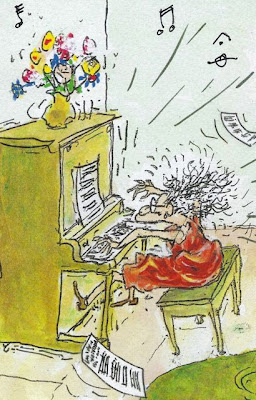We just learned that a former neighbor in Mt. Gretna, Ted Kramers, passed away last week. Ted was well into his nineties and still vigorous. He told me the following story about 10 years ago. It's the same story that Alex Ross relates in The Rest is Noise (p 343, Zero Hour: The US Army and German Music, 1945-1949), naming Ted as "John" Kramers. Other differences in our two accounts may relate partly to Ted's memory. He was in his late 80's when I spent several hours with him to record the details. (My memory is no better but I wrote notes.)
In April 1945 Ted, a major in a Civil Affairs unit, entered Germany with the 103rd Division of the US Army. The division moved east toward Munich and turned south toward Garmisch, Innsbruck, and the Brenner Pass, to link up with other American forces moving north from Italy. They felt safe, he said, and “loose” because they realized the Germans were on the run and the end of the war was near. But they were aware that they might stumble upon a “redoubt” where loyal units of the SS or Wehrmacht could make a last stand in the remote southern corner of Germany. Ted also remembers feeling then, as he said most American soldiers did, that the German army usually “played by the rules” and so he planned to be careful to “handle things correctly” as he dealt with the formalities of ending the war. Meyer Levin, in the Saturday Evening Post, described Ted as “a spirited fellow who whistled through a youthful blond moustache.” Ted’s wife, Ellen, confirmed that; his moustache by then white, Ted “wanted to move at the head of the pack” on their many tourist excursions all over the world.
Ted doesn’t know where the Strauss family went that day but believes that they learned within hours that they could return immediately; the Army was ahead of schedule and passed through the town without stopping. Neither Ted nor any other Americans ever occupied the villa.
After the war, having briefly accepted the post of head of the Reich Music Chamber (probably without an opportunity to decline and, he believed, “to do good and prevent even greater misfortune”), Strauss was automatically classified as “Grade I Guilty” by a denazification court and lost more of his assets. Many of his musician contemporaries treated him with contempt because he remained in Germany during the war and even conducted for the Nazi elite. (Toscanini said, "To Strauss the musician I take off my hat; to Strauss the man I put it on again.") In 1948 he was exonerated and reinstated as a German citizen. By then he and his family had been in exile in Switzerland where he wrote his exquisite Four Last Songs and Metamorphosen. Eventually he and his family returned to the villa in Garmisch several months before he died there in September 1949. Pauline passed away in 1950. The grandchildren still maintain the home (and a web site).
We will all miss Ted.








